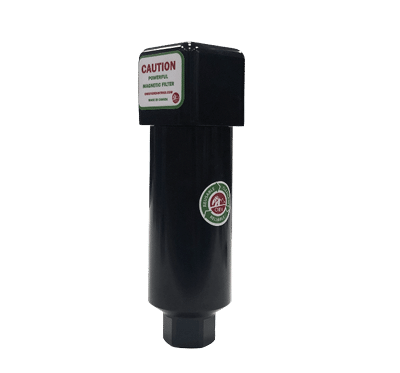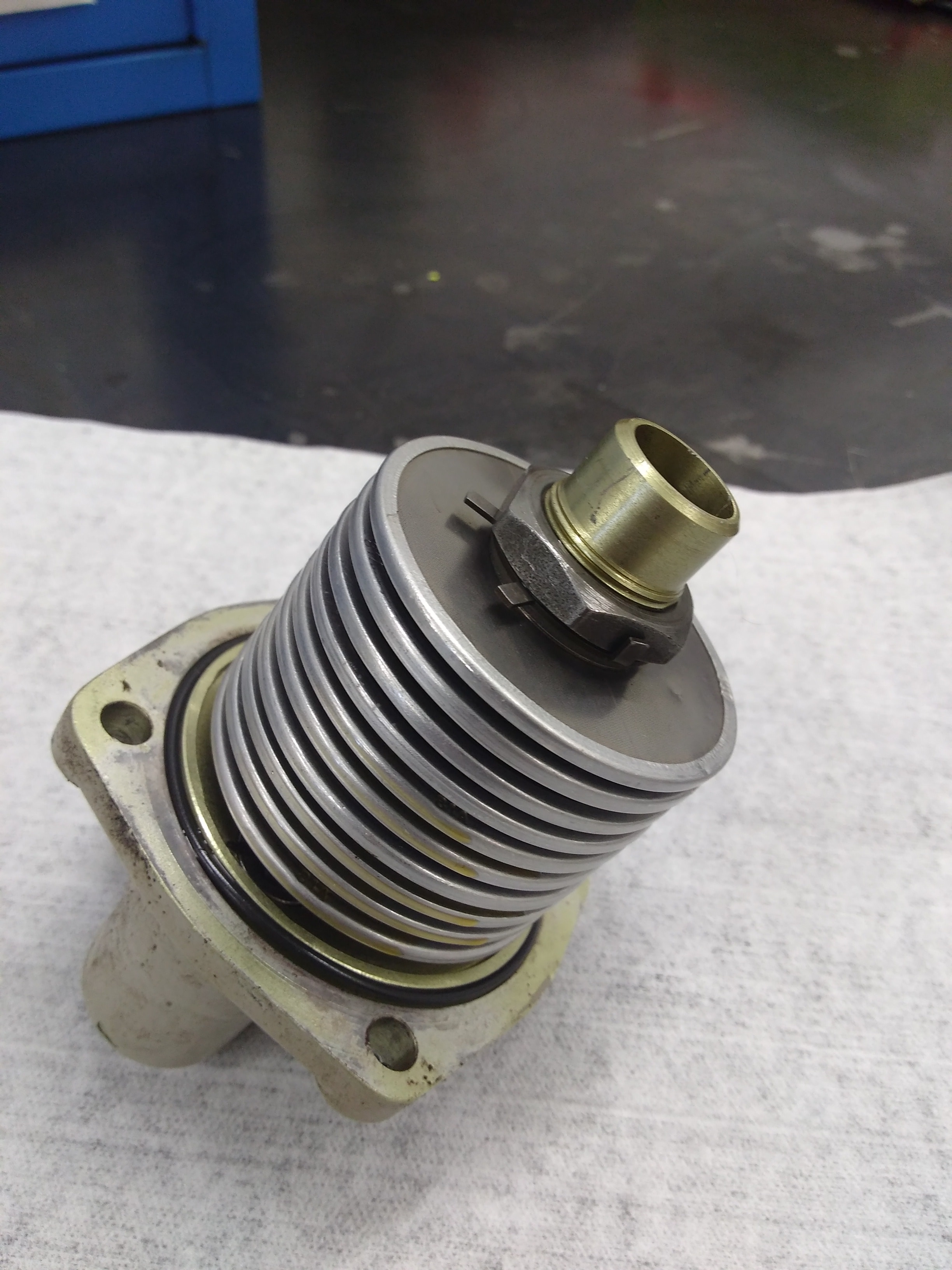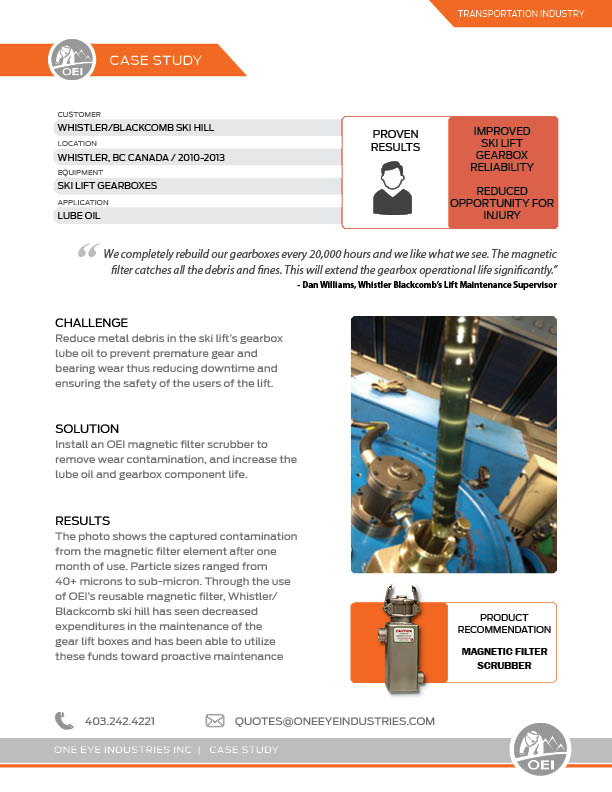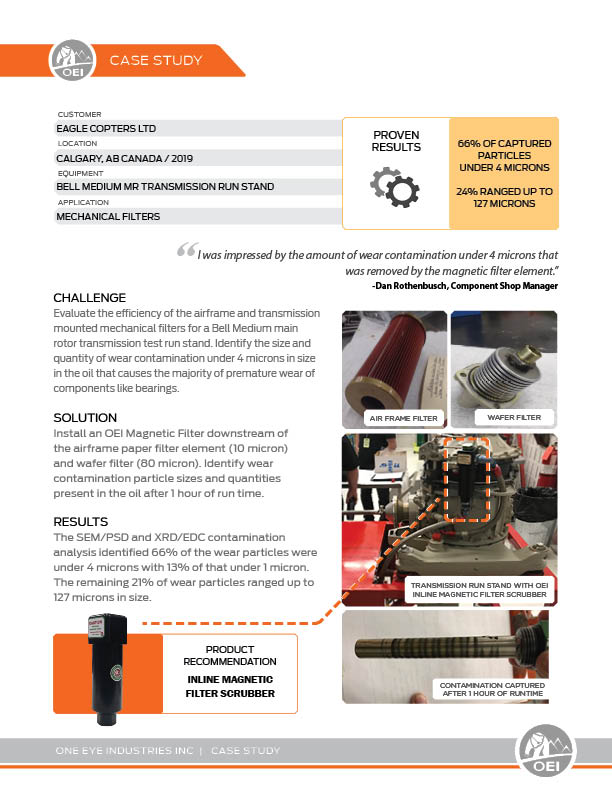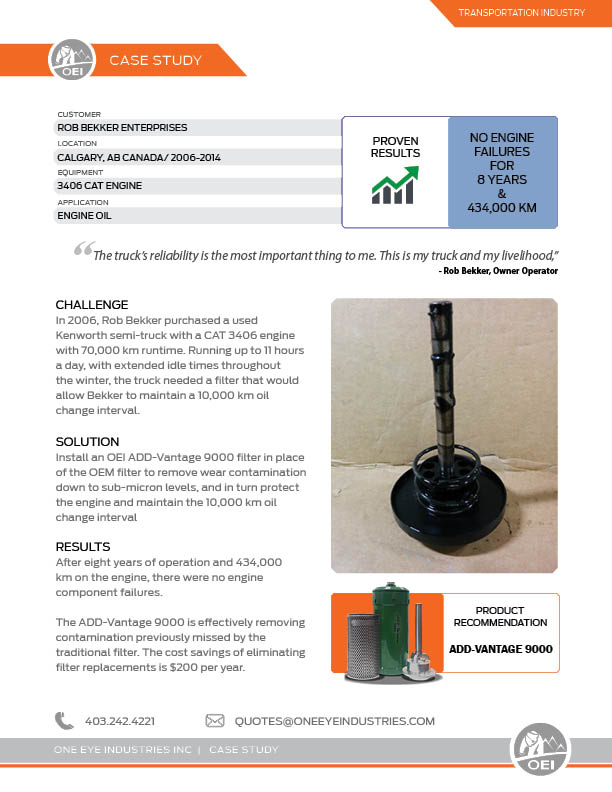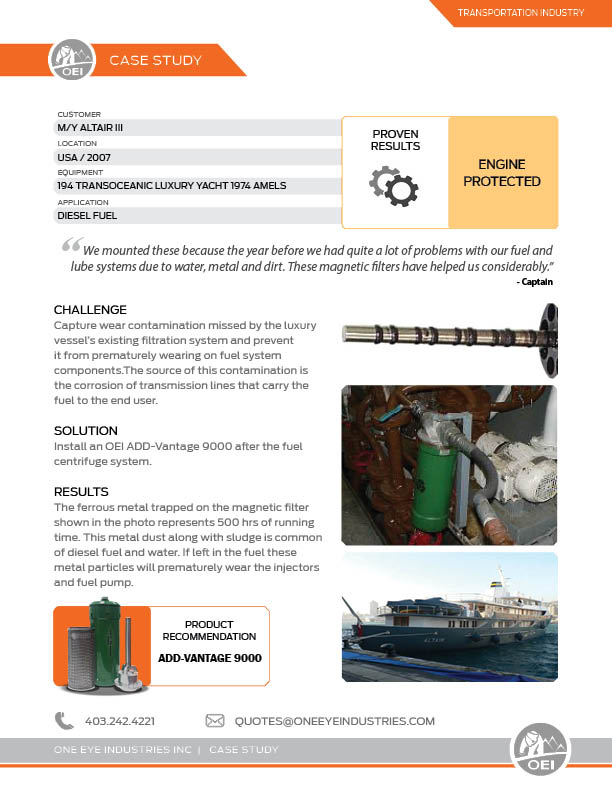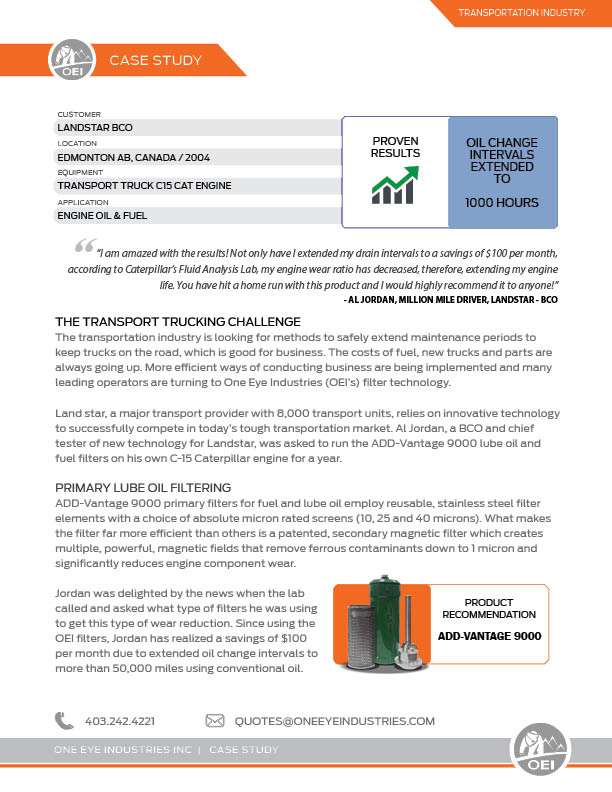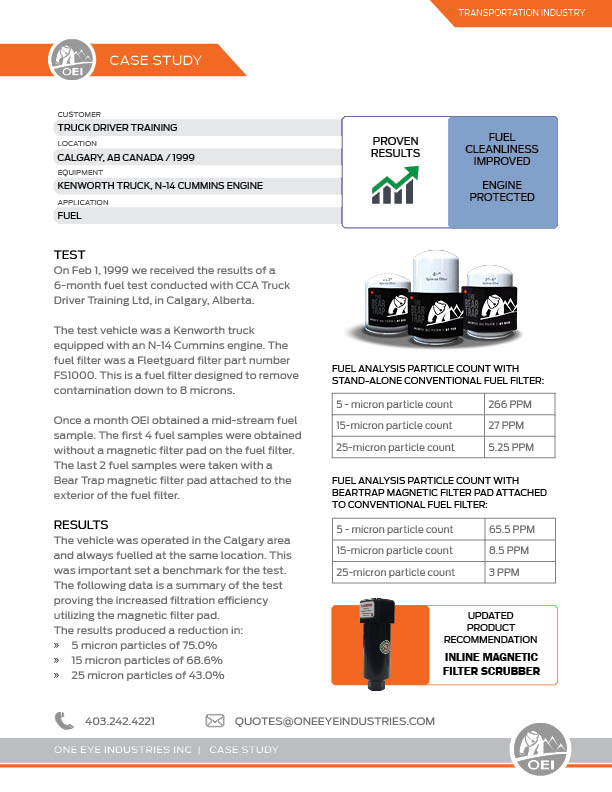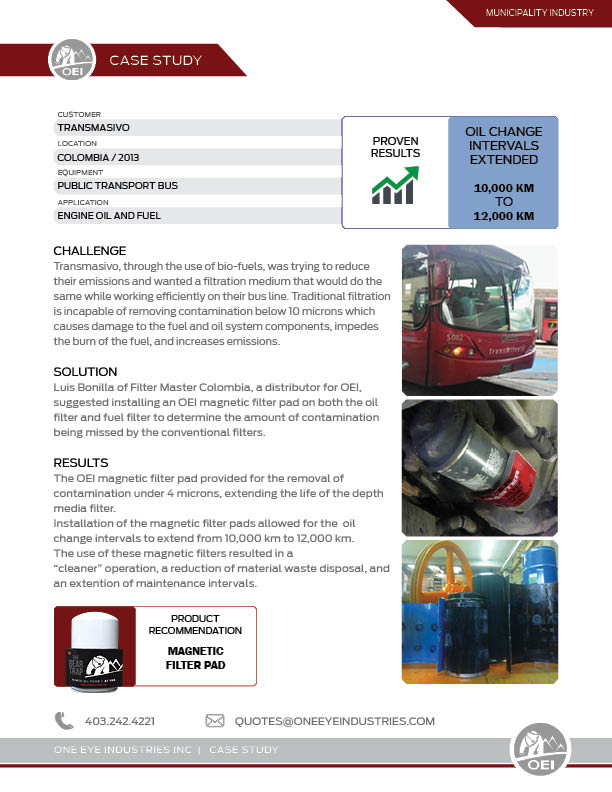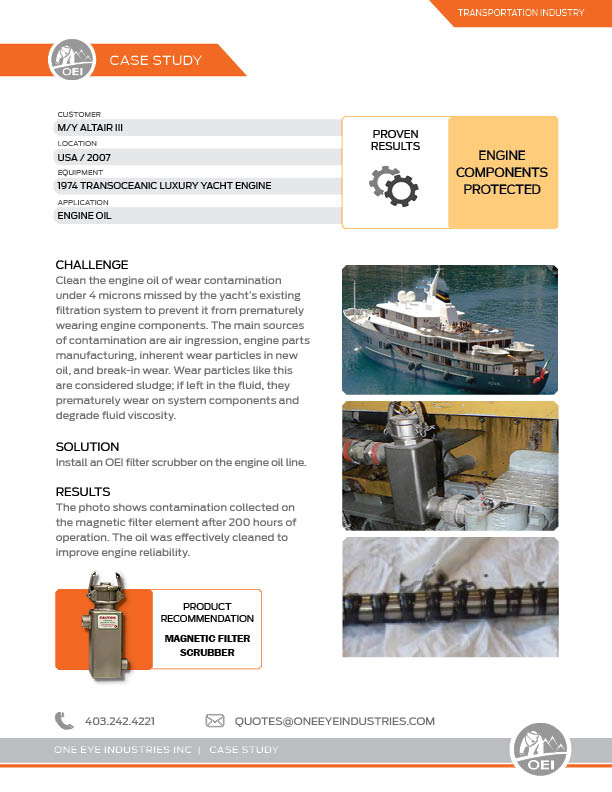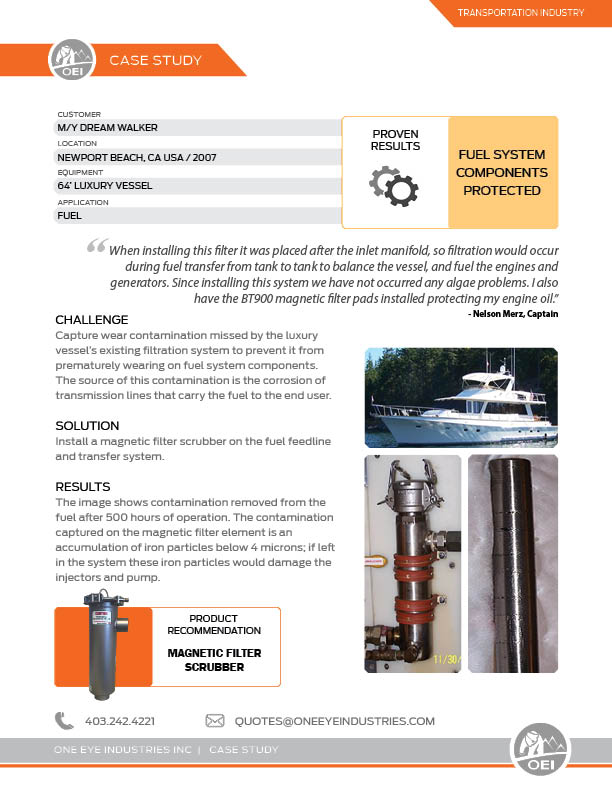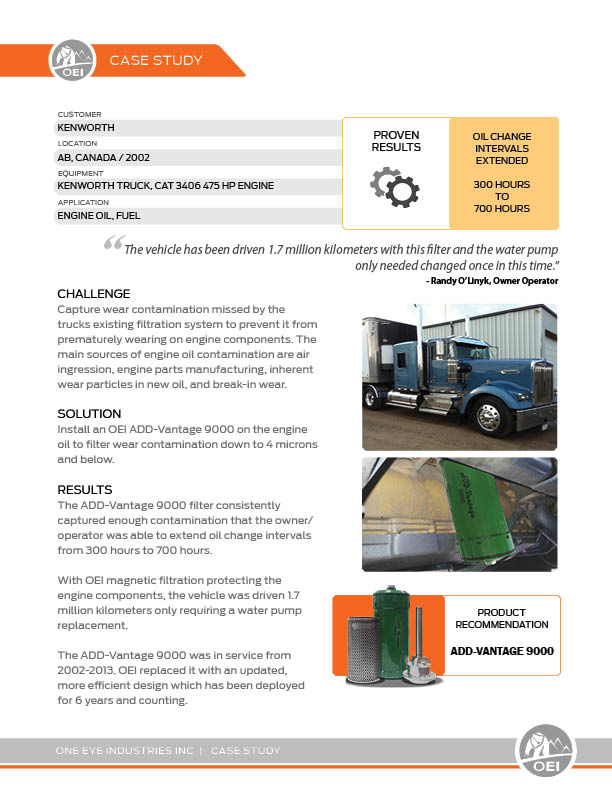Transportation
The two largest concerns regarding all forms of transport are their environmental impact and safe operations. Diesel emissions are gaining increasing scrutiny along with strict regulations. Quality filtration of wear contamination is the first step to protecting equipment, reducing labour requirements and improving emissions. OEI magnetic filters are proven to prevent scored injectors, damaged critical engine components, reduced lubrication quality and deteriorated hydraulic systems components to ensure responsible, cost effective equipment operation.
Feature Case Study
Proven Result:
-
66% of Captured Particles < 4 microns
-
24% of Captured Particles Ranged up to 127 microns
Customer
Location
Calgary, AB Canada / 2019
Equipment
Bell Medium MR Transmission Run Stand
Application
Mechanical Filters
Challenge
Install an OEI Magnetic Filter downstream of the airframe paper filter element (10 micron) and wafer filter (80 micron). Identify wear contamination particle sizes and quantities present in the oil after 1 hour of run time.
Solution
OEI’s ADD-Vantage 9000 was installed in the engine oil to capture submicron particulates, thereby extending fluid change intervals and equipment life.
Results
The SEM/PSD and XRD/EDC contamination analysis identified 66% of the wear particles were under 4 microns with 13% of that under 1 micron. The remaining 21% of wear particles ranged up to 127 microns in size.
SEM / PSD ANALYSIS
- SEM was used to observe and count the particles in the sample to obtain the particle size distribution. Size is measured by length in micrometers. Statistics and analysis is based on total counts measured by SEM. SEM was conducted on a JEOL – JSM300 LV.
- The results of SEM analysis showed that 13.1% of total particles were found to be under 1 micron and 65.9% of particles were found to be under 4 microns.
XRD / EDS ANALYSIS
- One of the magnetic filter samples received by SEMx Incorporated was analyzed using X-ray diffraction (XRD) and energy-dispersive X-ray spectroscopy (EDS).
- Solids were wiped off the filter and washed by solvent prior XRD EDS PSD analysis.
- The sample was finely crushed and ground using an Agate mortar and pestle in preparation for XRD and EDS analysis. XRD was employed to identify and quantify the phases present in the sample.
- XRD data was collected using a PANalytical Aeris X-ray diffractometer. Qualitative XRD analysis and Rietveld Refinement was performed using HighScore Plus XRD analysis software.
EDS was used to determine the elemental composition of the sample and helped to verify the results obtained with XRD quantification. EDS was conducted using a JEOL JED-2300 DRY SDD EDS detector. - This analysis quantifies the amount of both ferrous and non-ferrous wear contamination caught by OEI magnetic filter elements. Ferrous contamination presented at more than 78.6%, while non-ferrous contaminants, such as Chromium, Dolomite, Manganese and others totalled approximately 21.4%.
Transportation
RESULTS
Gearboxes and Transmissions
Improving Ski Lift Gearbox Reliability
The challenge was to reduce metal debris in the ski lift’s gearbox lube oil to prevent premature gear and bearing wear thus reducing downtime and ensuring the safety of the users of the lift.
Eagle Copters Transmission Run Stand
Evaluate the efficiency of the airframe and transmission mounted mechanical filters for a Bell Medium main rotor transmission test run stand. Identify the size and quantity of wear contamination under 4 microns in size in the oil that causes the majority of premature wear of components like bearings.
Engine Oil & Fuel
Transport Truck 10,000 km Oil Change Intervals
In 2006, Rob Bekker purchased a used Kenworth semi-truck with a CAT 3406 engine with 70,000 km runtime. Running up to 11 hours a day, with extended idle times throughout the winter, the truck needed a filter that would allow Bekker to maintain a 10,000 km oil change interval.
Transoceanic Yacht Fuel Pump Protection
The challenge was to capture wear contamination missed by the luxury vessel’s existing filtration system and prevent it from prematurely wearing on fuel system components.The source of this contamination is the corrosion of transmission lines that carry the fuel to the end user.
The 1000+ Hour Oil Change Interval Challenge
The transportation industry is looking for methods to safely extend maintenance periods to keep trucks on the road, which is good for business. The costs of fuel, new trucks and parts are always going up. Land star, a major transport provider with 8,000 transport units, relies on innovative technology to successfully compete in today’s tough transportation market. Al Jordan, a BCO and chief tester of new technology for Landstar, was asked to run the ADD-Vantage 9000 lube oil and fuel filters on his own C-15 Caterpillar engine for a year.
N-14 Cummins Engine Fuel Test
On Feb 1, 1999 we received the results of a 6-month fuel test conducted with CCA Truck Driver Training Ltd, in Calgary, Alberta. The test vehicle was a Kenworth truck equipped with an N-14 Cummins engine. The fuel filter was a Fleetguard filter part number FS1000. This is a fuel filter designed to remove contamination down to 8 microns. Once a month OEI obtained a mid-stream fuel sample. The first 4 fuel samples were obtained without a magnetic filter pad on the fuel filter. The last 2 fuel samples were taken with a Bear Trap magnetic filter pad attached to the exterior of the fuel filter.
Transmasivo Public Transport Bus Engine Oil
Transmasivo, through the use of bio-fuels, was trying to reduce their emissions and wanted a filtration medium that would do the same while working efficiently on their bus line. Traditional filtration is incapable of removing contamination below 10 microns which causes damage to the fuel and oil system components, impedes the burn of the fuel, and increases emissions.
Luxury Yacht Engine Protection
The challenge was to clean the engine oil of wear contamination under 4 microns missed by the yacht’s existing filtration system to prevent it from prematurely wearing engine components. The main sources of contamination are air ingression, engine parts manufacturing, inherent wear particles in new oil, and break-in wear. Wear particles like this are considered sludge; if left in the fluid, they prematurely wear on system components and degrade fluid viscosity.
Cummins Engine Diesel Fuel Test
The challenge was to exceed the filtration capability of the conventional fuel filter by installing a magnetic filter y-strainer on the fuel line of a 2006 Cummins 5.9 Liter Diesel Engine with 35,000 Miles (58,000 Km). Evaluate the ability for the magnetic filter to remove wear contamination down to 4 microns and below to prevent premature wear of the fuel system components: pumps, injectors, actuators, and cam shafts. The source of this contamination is the corrosion of transmission lines that carry the fuel to the end user.
Luxury Vessel Fuel Filtration
Capture wear contamination missed by the luxury vessel’s existing filtration system to prevent it from prematurely wearing on fuel system components.The source of this contamination is the corrosion of transmission lines that carry the fuel to the end user.
600 HP Diesel Locomotive Engine Protection
John Weaver, the Maintenance Manager of the Oilseed Processing Division, was looking for ways to prolong engine oil life of a 600 HP Diesel Locamotive engine that was operating 24/7. John wanted to extend oil change intervals without compromising oil viscosity. Regular maintenance called for the engine oil to be changed every 200 hours of operation. In addition regular checks on engine oil levels called for a gallon of oil to be added every week.
Kenworth Truck 17 Years of Engine Protection
The challenge was to capture wear contamination missed by the trucks existing filtration system to prevent it from prematurely wearing on engine components. The main sources of engine oil contamination are air ingression, engine parts manufacturing, inherent wear particles in new oil, and break-in wear.
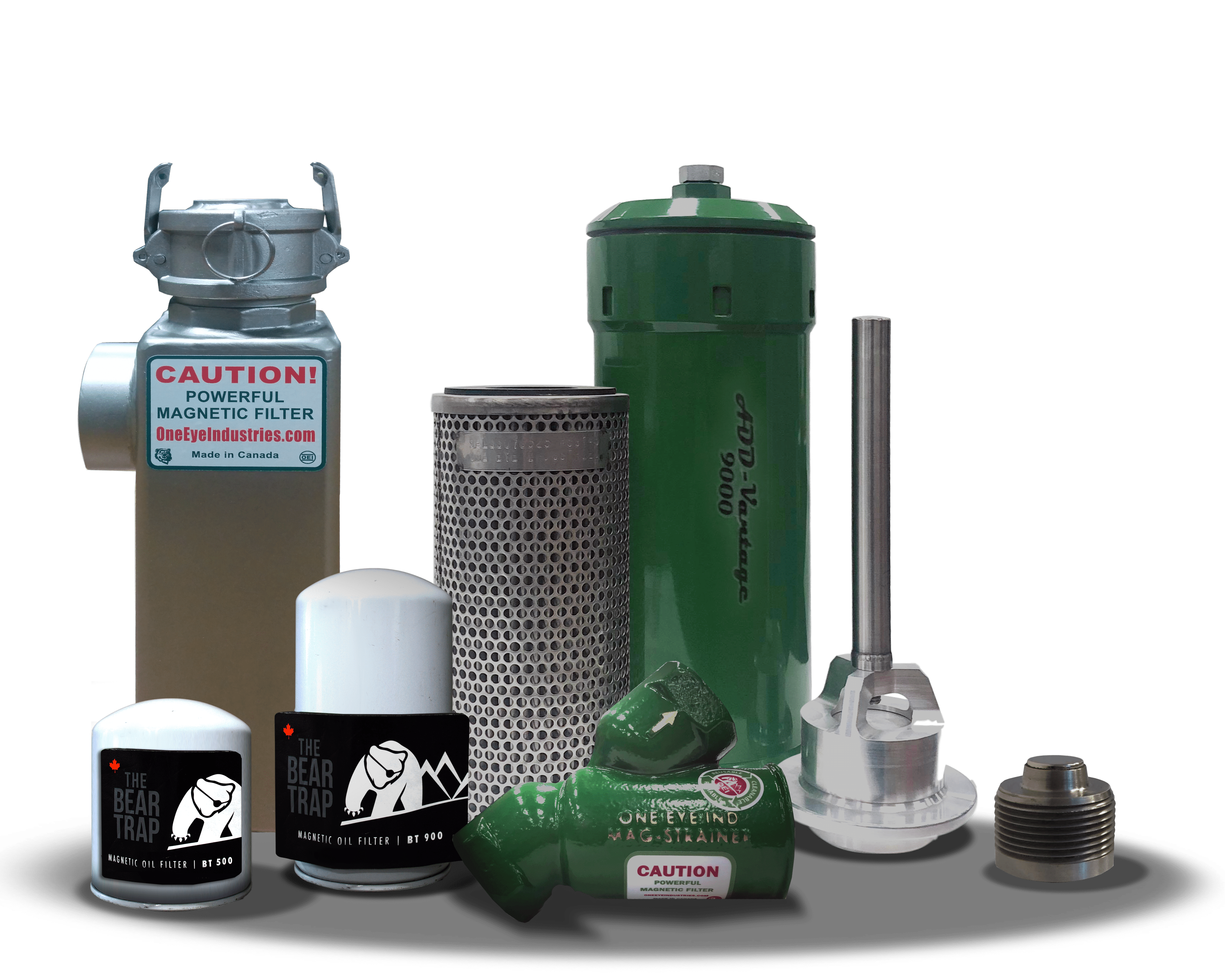
OEI magnetic filters are designed for 95+% efficiency: they are optimized for fluid viscosity, flow volume, flow rate, temperature, mobility, and mounting require- ments.
Use of the OEI Data Form will provide the necessary specifications for OEI to deter- mine which product is right for you.
Request a Quote

4344 12th Street SE Calgary,
AB T2G 3H9 Canada
(403) 242 4221
quotes@oneeyeindustries.com

